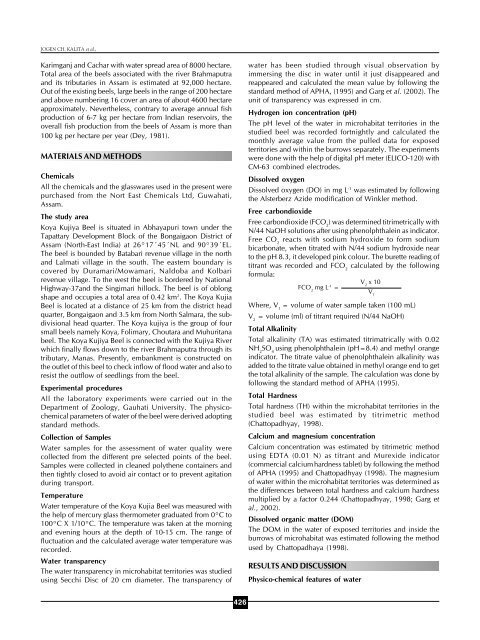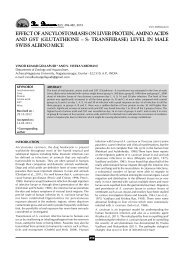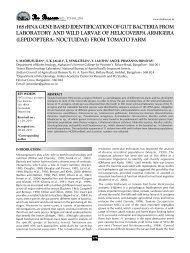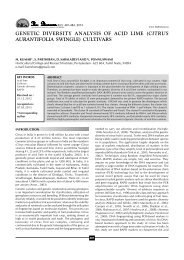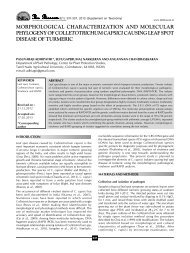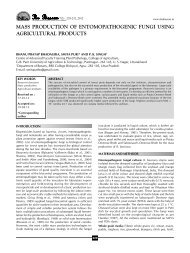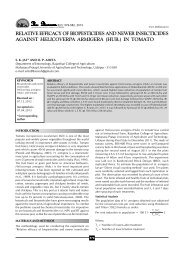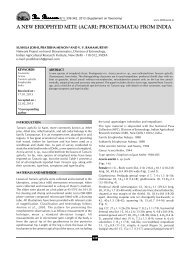NSave Nature to Survive - THE BIOSCAN
NSave Nature to Survive - THE BIOSCAN
NSave Nature to Survive - THE BIOSCAN
You also want an ePaper? Increase the reach of your titles
YUMPU automatically turns print PDFs into web optimized ePapers that Google loves.
JOGEN CH. KALITA et al.,<br />
Karimganj and Cachar with water spread area of 8000 hectare.<br />
Total area of the beels associated with the river Brahmaputra<br />
and its tributaries in Assam is estimated at 92,000 hectare.<br />
Out of the existing beels, large beels in the range of 200 hectare<br />
and above numbering 16 cover an area of about 4600 hectare<br />
approximately. Nevertheless, contrary <strong>to</strong> average annual fish<br />
production of 6-7 kg per hectare from Indian reservoirs, the<br />
overall fish production from the beels of Assam is more than<br />
100 kg per hectare per year (Dey, 1981).<br />
MATERIALS AND METHODS<br />
Chemicals<br />
All the chemicals and the glasswares used in the present were<br />
purchased from the Nort East Chemicals Ltd, Guwahati,<br />
Assam.<br />
The study area<br />
Koya Kujiya Beel is situated in Abhayapuri <strong>to</strong>wn under the<br />
Tapattary Development Block of the Bongaigaon District of<br />
Assam (North-East India) at 26°17´45´NL and 90°39´EL.<br />
The beel is bounded by Batabari revenue village in the north<br />
and Lalmati village in the south. The eastern boundary is<br />
covered by Duramari/Mowamari, Naldoba and Kolbari<br />
revenue village. To the west the beel is bordered by National<br />
Highway-37and the Singimari hillock. The beel is of oblong<br />
shape and occupies a <strong>to</strong>tal area of 0.42 km2 . The Koya Kujia<br />
Beel is located at a distance of 25 km from the district head<br />
quarter, Bongaigaon and 3.5 km from North Salmara, the subdivisional<br />
head quarter. The Koya kujiya is the group of four<br />
small beels namely Koya, Folimary, Choutara and Muhuritana<br />
beel. The Koya Kujiya Beel is connected with the Kujiya River<br />
which finally flows down <strong>to</strong> the river Brahmaputra through its<br />
tributary, Manas. Presently, embankment is constructed on<br />
the outlet of this beel <strong>to</strong> check inflow of flood water and also <strong>to</strong><br />
resist the outflow of seedlings from the beel.<br />
Experimental procedures<br />
All the labora<strong>to</strong>ry experiments were carried out in the<br />
Department of Zoology, Gauhati University. The physicochemical<br />
parameters of water of the beel were derived adopting<br />
standard methods.<br />
Collection of Samples<br />
Water samples for the assessment of water quality were<br />
collected from the different pre selected points of the beel.<br />
Samples were collected in cleaned polythene containers and<br />
then tightly closed <strong>to</strong> avoid air contact or <strong>to</strong> prevent agitation<br />
during transport.<br />
Temperature<br />
Water temperature of the Koya Kujia Beel was measured with<br />
the help of mercury glass thermometer graduated from 0°C <strong>to</strong><br />
100°C X 1/10°C. The temperature was taken at the morning<br />
and evening hours at the depth of 10-15 cm. The range of<br />
fluctuation and the calculated average water temperature was<br />
recorded.<br />
Water transparency<br />
The water transparency in microhabitat terri<strong>to</strong>ries was studied<br />
using Secchi Disc of 20 cm diameter. The transparency of<br />
426<br />
water has been studied through visual observation by<br />
immersing the disc in water until it just disappeared and<br />
reappeared and calculated the mean value by following the<br />
standard method of APHA, (1995) and Garg et al. (2002). The<br />
unit of transparency was expressed in cm.<br />
Hydrogen ion concentration (pH)<br />
The pH level of the water in microhabitat terri<strong>to</strong>ries in the<br />
studied beel was recorded fortnightly and calculated the<br />
monthly average value from the pulled data for exposed<br />
terri<strong>to</strong>ries and within the burrows separately. The experiments<br />
were done with the help of digital pH meter (ELICO-120) with<br />
CM-63 combined electrodes.<br />
Dissolved oxygen<br />
Dissolved oxygen (DO) in mg L-1 was estimated by following<br />
the Alsterberz Azide modification of Winkler method.<br />
Free carbondioxide<br />
Free carbondioxide (FCO 2 ) was determined titrimetrically with<br />
N/44 NaOH solutions after using phenolphthalein as indica<strong>to</strong>r.<br />
Free CO 2 reacts with sodium hydroxide <strong>to</strong> form sodium<br />
bicarbonate, when titrated with N/44 sodium hydroxide near<br />
<strong>to</strong> the pH 8.3, it developed pink colour. The burette reading of<br />
titrant was recorded and FCO 2 calculated by the following<br />
formula:<br />
FCO 2 mg L -1 =<br />
Where, V = volume of water sample taken (100 mL)<br />
1<br />
V = volume (ml) of titrant required (N/44 NaOH)<br />
2<br />
Total Alkalinity<br />
Total alkalinity (TA) was estimated titrimatrically with 0.02<br />
NH 2 SO 4 using phenolphthalein (pH=8.4) and methyl orange<br />
indica<strong>to</strong>r. The titrate value of phenolphthalein alkalinity was<br />
added <strong>to</strong> the titrate value obtained in methyl orange end <strong>to</strong> get<br />
the <strong>to</strong>tal alkalinity of the sample. The calculation was done by<br />
following the standard method of APHA (1995).<br />
Total Hardness<br />
Total hardness (TH) within the microhabitat terri<strong>to</strong>ries in the<br />
studied beel was estimated by titrimetric method<br />
(Chat<strong>to</strong>padhyay, 1998).<br />
Calcium and magnesium concentration<br />
Calcium concentration was estimated by titrimetric method<br />
using EDTA (0.01 N) as titrant and Murexide indica<strong>to</strong>r<br />
(commercial calcium hardness tablet) by following the method<br />
of APHA (1995) and Chat<strong>to</strong>padhyay (1998). The magnesium<br />
of water within the microhabitat terri<strong>to</strong>ries was determined as<br />
the differences between <strong>to</strong>tal hardness and calcium hardness<br />
multiplied by a fac<strong>to</strong>r 0.244 (Chat<strong>to</strong>padhyay, 1998; Garg et<br />
al., 2002).<br />
Dissolved organic matter (DOM)<br />
The DOM in the water of exposed terri<strong>to</strong>ries and inside the<br />
burrows of microhabitat was estimated following the method<br />
used by Chat<strong>to</strong>padhaya (1998).<br />
RESULTS AND DISCUSSION<br />
Physico-chemical features of water<br />
V x 10 2<br />
V1


